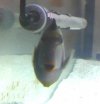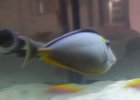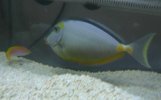Marine fish (teleosts) have the exact opposite problem to that encountered by freshwater teleosts. Their body fluids are, again, 1/3 of that of sea water but this time they are in sea water so their body fluids are hypoosmotic to their environment. As a result they will tend to lose water by osmosis to the environment through their skin but mostly through their gills. Consequently, they have developed mechanisms and behaviour to compensate for this water loss. Firstly, the kidneys of marine teleosts are modified in such a way that very little water is extracted from the blood, some species even lack certain kidney structures and can't eliminate water (Gordon, 1977; Moyle and Cech, 1982). This results in a reduction in the loss of water by the production of urine. However, water is still being lost by the gills and this cannot be stopped, so the only method left is to somehow replace the water as quickly as it is lost. Marine teleosts accomplish this by actually drinking water, the most reliable drinking rates reported in the literature range from 3-10 ml/(kg hr) (Gordon, 1977). However, drinking water by itself cannot solve the problem, a complex series of events must first occur in the digestive tract. These events are not yet well understood but it is known that most of the water is absorbed as are the monovalent ions Na+ and Cl- (they are, after all, drinking salt water!), while the divalent ions (such as magnesium and sulfates) are excreted by the kidneys (Gordon, 1977). Sodium (Na+) and chloride (Cl-) also move by diffusion into the body through the gills. Therefore, Na+ and Cl- ions will accumulate in the body of the fish and must be eliminated, this is accomplished by special cells in the gills called chloride cells, which me these ions out of the body by active transport (Moyle and Cech, 1982; Gordon, 1977).




